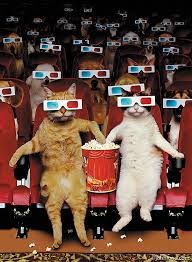 In my classes I often use well-known movies to illustrate writing techniques, as do many writing coaches. Being a visual society, we are apt to more easily grasp writing skills if we can picture them unfolding on the screen. If you watch movies as a writer, I guarantee you’ll never approach films or your work the same way.
In my classes I often use well-known movies to illustrate writing techniques, as do many writing coaches. Being a visual society, we are apt to more easily grasp writing skills if we can picture them unfolding on the screen. If you watch movies as a writer, I guarantee you’ll never approach films or your work the same way.
Writing Tip for Today: Here are some easy ways to use movies as a teaching tool for your own writing:
Musical Cues
If you’ve ever been involved with theater, you might know that actors often use cues to remember the story. In movies, the audience is given musical cues among others. For instance, if the music suddenly changes, you know the emotion or mood of the next part will be different. A fun way to test your work for cues: imagine or find You Tube music that complements the story as it proceeds from plot point to plot point, scene to scene. You’d pick cheerful music for a happy scene, eerie or melancholy music to signify sad or ominous happenings. See if your story obeys the same sequence of musical cues as in a movie of the same genre.
Managing Tension
In looking for movie cues, you can also take a look at the way the movie uses the camera. In fast-paced scenes, there are often quick cut-aways of long shots to closeups and back again to communicate tension and conflict. Happier moments in a film are generally brief and are often illustrated with a montage or slo-mo (think of a couple running toward each other in slo-mo). To translate this into your novel, use shorter, active verb sentences (even some fragments) to make a scene feel tense and urgent. Happier or routine moments are often best summarized instead of acted out in a scene.
As you get better at seeing these points in a film, you may be able to locate plot points. A plot point is an event which changes the story’s direction or makes the character recalculate a strategy to win the goal. In many stories, these are setbacks and failures, because if the character wins the goal, story is over. See if you can identify these places in a film. Try to let your gut be your guide, as overanalyzing may frustrate you. Most stories have 4 plot points: An inciting Incident, “two Things Get Worse” points and the climax scene. Try to identify these spots in movies as well as in your story.
Character Changes
While there are many more things writers can learn from deconstructing movies, another easy one is to observe the film’s main character. Identify this person’s attitudes and emotions on a continuum. She might go from naïve, hopeful and happy to doubtful, then cynical, in battle mode for the climax and finally older and wiser in the resolution. Does your story character grow in a similar way? Note that big life changes are usually not sudden but an accumulation of successes and failures, stumbles and wins. After you watch a few movies as a writer instead of only as entertainment, you’ll get better at seeing these different elements. Your stories will be more compelling as you implement movie techniques that are audience winners. And like I said, you’ll never be able to watch a movie again without looking for mood changes, plot points and the character’s arc. Grab your popcorn and tell people you’re working!




